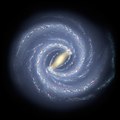| Messier 54 | |
|---|---|
 M54 by Hubble Space Telescope; 3.4′ view | |
| Observation data (J2000 epoch) | |
| Class | III [1] |
| Constellation | Sagittarius |
| Right ascension | 18h 55m 03.33s [2] |
| Declination | −30° 28′ 47.5″ [2] |
| Distance | 87.4 kly (26.8 kpc) [3] |
| Apparent magnitude (V) | 7.6 [4] |
| Apparent dimensions (V) | 12.0′ |
| Physical characteristics | |
| Radius | 153 ly [5] |
| Estimated age | 13 Gyr [6] |
| Notable features | Probably extragalactic |
| Other designations | M54, [7] NGC 6715, [7] GCl 104, [7] C 1851-305 [7] |
Messier 54 (also known as M54 or NGC 6715) is a globular cluster in the constellation Sagittarius. [a] It was discovered by Charles Messier in 1778 and then included in his catalog of objects that could be mistaken for comets.
Contents
It is easily found in the sky, being close to the star ζ Sagittarii. It is, however, not resolvable into individual stars even with larger amateur telescopes.
In July 2009, a team of astronomers reported that they had found evidence of an intermediate-mass black hole in the core of M54. [8]


